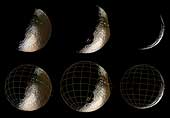|
COMETS EARTH JUPITER KUIPER BELT MARS MERCURY METEORITES NEPTUNE OORT CLOUD PLUTO SATURN SOLAR SYSTEM SPACE SUN URANUS VENUS ORDER PRINTS
PHOTO CATEGORIES SCIENCEVIEWS AMERICAN INDIAN AMPHIBIANS BIRDS BUGS FINE ART FOSSILS THE ISLANDS HISTORICAL PHOTOS MAMMALS OTHER PARKS PLANTS RELIGIOUS REPTILES SCIENCEVIEWS PRINTS
|
Related Documents
Download Options
These spectacular Cassini images of Saturn's moon Iapetus show an enticing world of contrasts. These are the sharpest views of Iapetus from Cassini so far, and they represent better resolution than the best images of this moon achieved by NASA's Voyager spacecraft. Images obtained using ultraviolet (centered at 338 nanometers), green (568 nanometers) and infrared (930 nanometers) filters were combined to produce the enhanced color views at left and center; the image at the right was obtained in visible white light. The images on the bottom row are identical to those on top, with the addition of an overlying coordinate grid. These views show parts of the moon's anti-Saturn side--the side that faces away from the ringed planet--which will not be imaged again by Cassini until Sept., 2007. In the central view, part of the moon's eastern edge was not imaged and appears to be cut off. With a diameter of 1,436 kilometers (892 miles), Iapetus is Saturn's third largest moon. It is famous for the dramatic contrasts in brightness on its surface--the leading hemisphere is as dark as a freshly-tarred street, and the trailing hemisphere and poles almost as bright as snow. Many impact craters can be seen in the bright terrain and in the transition zone between bright and dark, and for the first time in parts of the dark terrain. Also visible is a line of mountains that appear as a string of bright dots in the two color images at left, and on the eastern limb in the image at right. These mountains were originally detected in Voyager images, and might compete in height with the tallest mountains on Earth, Jupiter's moon Io and possibly even Mars. Further observations will be required to precisely determine their heights. Interestingly, the line of peaks is aligned remarkably close to the equator of Iapetus. The large circular feature rotating into view in the southern hemisphere is probably an impact structure with a diameter of more than 400 kilometers (250 miles), and was first seen in low-resolution Cassini images just two months earlier. Theses images were taken with the Cassini spacecraft narrow angle camera between Oct, 15 and 20, 2004, at distances of 1.2, 1.1 and 1.3 million kilometers (746,000, 684,000 and 808,000 miles) from Iapetus, respectively. The Sun-Iapetus-spacecraft, or phase, angle changes from 88 to 144 degrees across the three images. The image scale is approximately 7 kilometers (4.5 miles) per pixel. |
